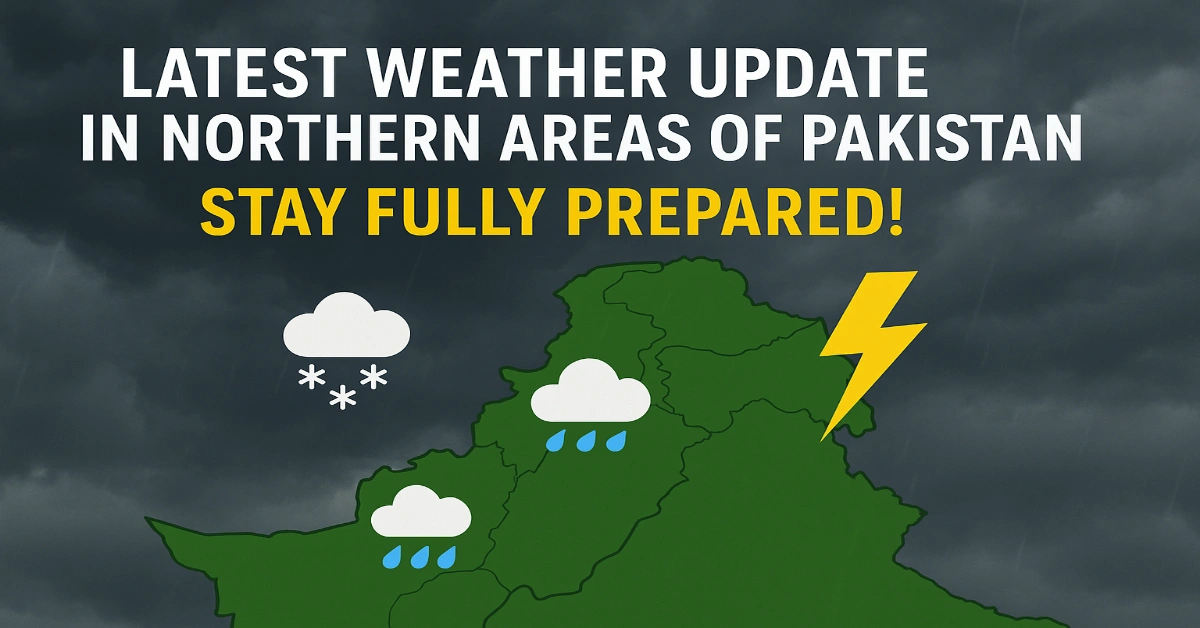Stay updated with the latest temperature, rain, and road safety news in Northern Areas of Pakistan. Simple guidance helps locals and travelers plan safe, risk-free trips in every season.
Latest Weather Updates in Northern Areas of Pakistan: An Overview
The northern regions face quick weather changes that affect travel, safety, and daily life. Temperatures can drop suddenly, with chances of rain or snowfall in many valleys. Roads may become blocked, so travelers and locals should check updates before planning any journey. Reliable forecasts help people stay safe, save time, and avoid risks. Whether it is summer tourism or winter snow, being prepared makes travel easier and more enjoyable.
SAMAA TV:https://www.youtube.com/@Samaatv
In these northern regions, weather changes quickly and can affect travel.
Gilgit-Baltistan: Expect cold nights, cool days, and snowfall in higher peaks. Sudden rain may cause landslides or road closures.
Khyber Pakhtunkhwa: Mostly mild weather with chances of rain in hilly zones. Evenings can turn colder than expected.
Travel Tip: Always check local updates before trips to avoid delays and stay safe
Impact of Current Weather on Local Life and Tourist Activities
Changing weather shapes daily life and travel in the northern regions.
For Locals: Heavy rain or snow often blocks roads, slows transport, and affects business and farming. Families also adjust routines to stay safe and warm.
For Tourists: Clear weather supports sightseeing, trekking, and smooth travel. But sudden showers or snowfall can close mountain routes and limit outdoor plans.
Helpful Tip: Keeping track of daily forecasts allows both locals and visitors to manage time better and enjoy the region with confidence.
Road and Travel Conditions in Northern Areas: What You Need to Know
Roads in the northern areas are often affected by rainfall, snowfall, and landslides, especially in winter. Main highways like the Karakoram Highway and routes to Hunza, Skardu, and Gilgit can face temporary blockages after heavy snow or rockfalls. Travelers should:
Check latest weather updates before leaving.
Carry warm clothes and food, as delays are common.
Use 4×4 vehicles in snow-covered regions for safe driving.
Plan extra travel time, as roads may open or close suddenly.
With the right preparation, travel in these areas can be safe and enjoyable.
Also Read:5.1 Earthquake – 75 km south of Fayzabad-Get More Details!
How Local Communities Are Preparing for Changing Weather
Communities in the northern areas are taking smart steps to face sudden weather changes.
Storing Food and Fuel: Families keep extra supplies for days when roads are closed.
Stronger Homes: Locals repair roofs and walls to handle heavy rain or snow.
Early Warnings: Villagers share quick alerts about landslides, floods, or blocked roads.
Travel Planning: Drivers and shopkeepers check forecasts daily to avoid delays.
Community Support: Neighbors help each other with shelter, food, and transport during tough days.
Best Gear for Cold Weather: What to Pack for Your Trip
Planning a trip to cold places means you need the right gear to stay safe and enjoy your journey. The best gear for cold weather is not only about style but also about comfort and protection. Here’s what you should pack:
Layered Clothing: Thermal inners, woolen sweaters, and a windproof jacket to keep your body warm.
Strong Footwear: Waterproof boots with thick soles to walk safely on snow and slippery paths.
Winter Accessories: Woolen cap, scarf, insulated gloves, and warm socks to protect against freezing air.
Travel Must-Haves: A durable backpack, hot water bottle, and warm blanket for long journeys.
Emergency Items: First-aid kit, flashlight, extra batteries, and a power bank for unexpected situations.
Food & Drinks: High-energy snacks like nuts and chocolates, plus a thermos for hot tea or coffee.
With this smart packing list, your trip will be warm, safe, and full of comfort—even in freezing weather.
Rainfall and Snowfall Predictions for the Coming Week
Weather experts expect light to moderate rainfall in the lower valleys during the next few days, while snowfall is likely on higher mountain peaks. Travelers should plan carefully, as sudden showers may slow road journeys, and snowfall can make some routes slippery. Locals can also prepare by storing essentials and keeping warm. For tourists, keeping an eye on daily weather updates is the best way to enjoy trips safely.

Safety Tips for Travelers in Harsh Weather Conditions
Travel in the Northern Areas of Pakistan can be risky during harsh weather, so always check updates before starting your trip. Warm clothing, food, and a charged phone are must-haves. Roads in the Northern Areas of Pakistan can get slippery, so drive slowly and stay alert. Inform someone about your route because the Northern Areas of Pakistan are remote, and quick help may not always be available.
Agricultural Impact: How Weather Changes Are Affecting Local Farming
In the Northern Pakistan, changing weather is reducing crop yields and making farming unpredictable. Farmers in the Northern Areas of Pakistan face water shortages, soil erosion, and crop damage from floods and droughts. To survive, the Northern Areas of Pakistan are shifting towards stronger seeds, new planting methods, and water-saving techniques.
How to Stay Informed: Real-Time Weather Alerts for Travelers
If you are visiting the Northern Areas of Pakistan, always check real-time weather alerts to stay safe. Many apps and local services in the Northern Areas of Pakistan give instant updates about rain, snow, or road blocks. By following real-time alerts in the Northern Areas of Pakistan, travelers can plan better and avoid risks.




Join The Discussion